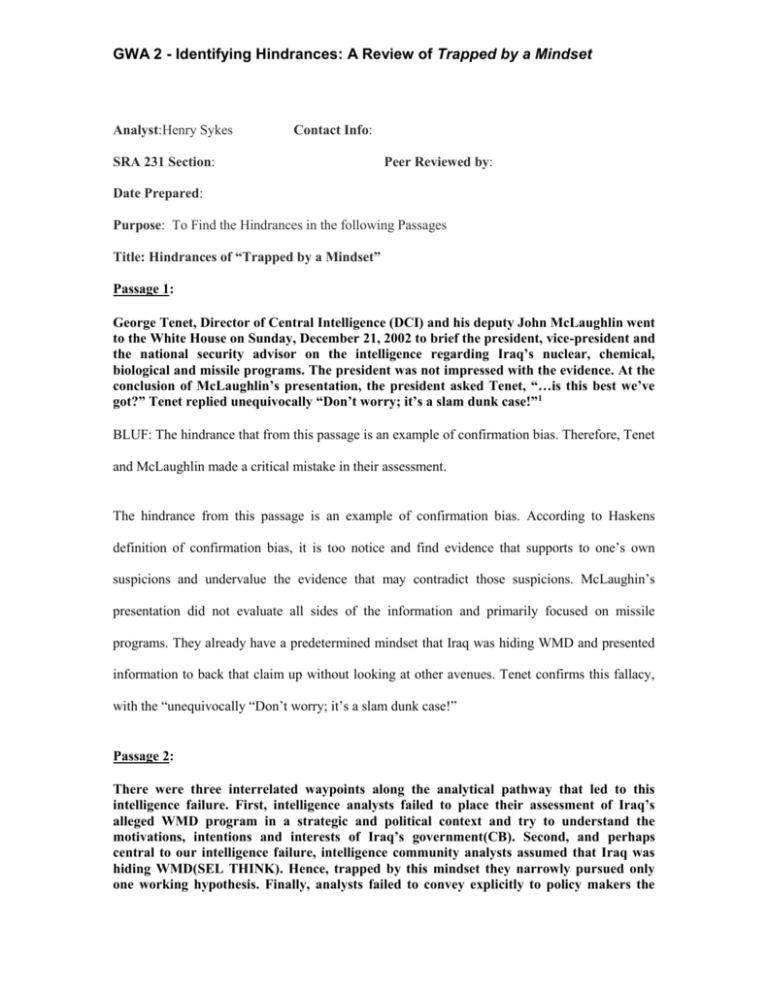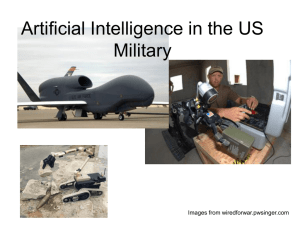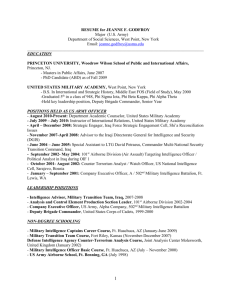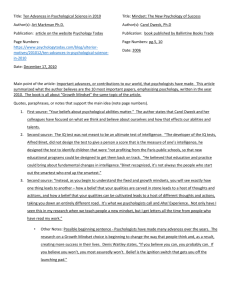Sykes.H__GWA-2__Identifying_Hindrances
advertisement

GWA 2 - Identifying Hindrances: A Review of Trapped by a Mindset Analyst:Henry Sykes Contact Info: SRA 231 Section: Peer Reviewed by: Date Prepared: Purpose: To Find the Hindrances in the following Passages Title: Hindrances of “Trapped by a Mindset” Passage 1: George Tenet, Director of Central Intelligence (DCI) and his deputy John McLaughlin went to the White House on Sunday, December 21, 2002 to brief the president, vice-president and the national security advisor on the intelligence regarding Iraq’s nuclear, chemical, biological and missile programs. The president was not impressed with the evidence. At the conclusion of McLaughlin’s presentation, the president asked Tenet, “…is this best we’ve got?” Tenet replied unequivocally “Don’t worry; it’s a slam dunk case!”1 BLUF: The hindrance that from this passage is an example of confirmation bias. Therefore, Tenet and McLaughlin made a critical mistake in their assessment. The hindrance from this passage is an example of confirmation bias. According to Haskens definition of confirmation bias, it is too notice and find evidence that supports to one’s own suspicions and undervalue the evidence that may contradict those suspicions. McLaughin’s presentation did not evaluate all sides of the information and primarily focused on missile programs. They already have a predetermined mindset that Iraq was hiding WMD and presented information to back that claim up without looking at other avenues. Tenet confirms this fallacy, with the “unequivocally “Don’t worry; it’s a slam dunk case!” Passage 2: There were three interrelated waypoints along the analytical pathway that led to this intelligence failure. First, intelligence analysts failed to place their assessment of Iraq’s alleged WMD program in a strategic and political context and try to understand the motivations, intentions and interests of Iraq’s government(CB). Second, and perhaps central to our intelligence failure, intelligence community analysts assumed that Iraq was hiding WMD(SEL THINK). Hence, trapped by this mindset they narrowly pursued only one working hypothesis. Finally, analysts failed to convey explicitly to policy makers the GWA 2 - Identifying Hindrances: A Review of Trapped by a Mindset ambiguity of their evidence and the reality that their conclusions were far from an analytical “slam dunk.”(PL) BLUF: The three waypoints that lead to the failure of the intelligence agencies can be described with the hindrances of confirmation bias, personal biases, and perception limitation. The three waypoints that led to the intelligence failure can be described with the hindrances confirmation bias, personal biases, and perception limitation. With the first waypoint is confirmation bias (notice and look for information that confirms one’s own beliefs) because they failed to put the assessment of Iraq’s “alleged” WMD program into proper context. Thus they failed “. . . to understand the motivations, intentions and interests of Iraq’s government”. The second waypoint where the analysts assumed that Iraq was hiding WMDs, is personal biases. Hasken’s definition of personal biases states that we have these predetermined thoughts that “make it difficult to remain objective and think critically.” The Analysts had this inkling that the Iraq had a WMD program which only narrowed their thought process to that one working hypothesis. The final waypoint is an example of perception limitation. Perception limitation defined according to Hasken is, “Being unaware of our own perception limitations that can lead to misconceptions about reality.” The failure of the analyst to accurately describe the ambiguity of the evidence led to the policy makers to make a big “misconception” in their concluding assessments. Passage 3: More ominously, the 2002 NIE asserted that Iraq had a robust biological weapons (BW) program and “that all key aspects—R&D (research and development), production, and weaponization—of Iraq’s offensive BW program are active and that most elements are larger and more advanced than they were before the Gulf War.” The foundation of this sweeping intelligence judgment essentially rested on the information provided by one GWA 2 - Identifying Hindrances: A Review of Trapped by a Mindset questionable source known ironically as Curveball, who unfortunately turned out to be an elaborate fabricator. Interviews with Curveball were conducted by another foreign service that never allowed the United States access, and the Defense Intelligence Agency (DIA) never tried to independently validate Curveball’s veracity; nevertheless, the Curveball fabrications became not only the basis for the NIE’s sweeping BW assessments but were also included in the President’s 2003 State of the Union speech and the Secretary of State’s presentation to the United Nations Security Council.8 BLUF: The NIE made the hindrance of using testimonial evidence. Proper procedures in securing validation of source could have prevented wrong assessments. The hindrance of NIE fallacy can be identified with testimonial evidence. Hasken’s definition of testimonial evidence is the reliance of information that backs up one’s own beliefs from a questionable source that is subjective and unreliable. The NIE used the information from Curveball without appropriate confirmation of the source provide too them. If the NIE took proper procedures and precautions in making sure the source of the information were valid, then this mistake could have potentially been avoided. Passage 4: Pillar acknowledged that while the administration cherry-picked raw intelligence for public dissemination used policy to drive intelligence and created an environment of hostility between analysts and policy makers, they did not engage in crude arm-twisting to change analytical assessments or judgments. Moreover, he too quickly absolves the intelligence community of its responsibility when he writes regarding the 2002 NIE, that although it “was flawed…it was not what led to the war.”11 While Pillar is correct that the NIE was not the proximate casus belli, he is incorrect to undervalue the potential influence of a more nuanced NIE on Congress, and perhaps even the White House. A more accurate report would have reflected the uncertain nature of the evidence and the possibility that Iraq’s WMD programs were far less robust than many assumed. BLUF: The hindrances in this passage can be described with personal biases and prejudices and perception limitation. Hindrances invoked causes wrong assessment of responsibility for causation of war. The hindrances exemplified in this passage can be accredited to personal biases and prejudices and perception limitation. The definition of personal biases and prejudices are having GWA 2 - Identifying Hindrances: A Review of Trapped by a Mindset predetermined notions that obfuscate the ability to think critically and remain objective. Pillar noted that the analysts and policy makers refused to change their analytical assessments and judgments due to their personal biases. Pillar then displayed the hindrance of perception limitation because he absolved responsibility of the NIE and undervalued the influence the NIE had on the congress and white house. Pillar did not focus on the facts, in that the evidence presented had a high amount of uncertainty, and in return created the misconception that NIE assumed less responsibility when they should have invoked more.







